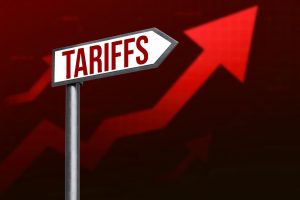 Since President Trump took office on January 20, 2025, the administration has implemented significant changes to U.S. trade policy, including most notably with respect to tariffs. Within weeks of taking office, the White House announced changes to tariffs on steel and aluminum which placed a tariff of 25% on all such imports. New tariffs were also separately imposed on imports from Canada, Mexico and China subject to certain exceptions. Then, on April 2, President Trump announced “reciprocal” tariffs on most imports from most countries, branding the day as “Liberation Day” and one of “American industry rebirth.” These tariffs, which include a 10% baseline rate and higher specific tariffs targeting China, Vietnam and the EU, among others, prompted heightened concerns about a trade war. Then, on April 9, President Trump announced that although the 10% baseline reciprocal tariff will remain effect, the higher reciprocal tariffs will be postponed for 90 days—except for China, for which the reciprocal tariff and duties are being increased to 105%, which are being applied in addition to prior 20% duties and the Section 301 duties.
Since President Trump took office on January 20, 2025, the administration has implemented significant changes to U.S. trade policy, including most notably with respect to tariffs. Within weeks of taking office, the White House announced changes to tariffs on steel and aluminum which placed a tariff of 25% on all such imports. New tariffs were also separately imposed on imports from Canada, Mexico and China subject to certain exceptions. Then, on April 2, President Trump announced “reciprocal” tariffs on most imports from most countries, branding the day as “Liberation Day” and one of “American industry rebirth.” These tariffs, which include a 10% baseline rate and higher specific tariffs targeting China, Vietnam and the EU, among others, prompted heightened concerns about a trade war. Then, on April 9, President Trump announced that although the 10% baseline reciprocal tariff will remain effect, the higher reciprocal tariffs will be postponed for 90 days—except for China, for which the reciprocal tariff and duties are being increased to 105%, which are being applied in addition to prior 20% duties and the Section 301 duties.
Articles Posted in D&O
How Trump’s DEI Rollback Affects Nonprofits and How to Protect Your Organization
 Since taking office, President Trump has issued sweeping executive orders targeting Diversity, Equity, and Inclusion (DEI) initiatives across federal agencies and directing agencies to take action to encourage private organizations to follow suit. On January 20, 2025, President Trump signed executive orders (EOs) titled Ending Racial and Wasteful Government DEI Programs and Preferencing and Extremism and Restoring Biological Truth to the Federal Government. The following day, he issued another EO titled Ending Illegal Discrimination and Restoring Merit-Based Opportunity. On January 22, 2025, the White House published a Fact Sheet providing guidance related to these orders. Many states were early adopters of such initiatives—e.g., in 2023 Florida passed a bill banning DEI initiatives in public colleges—or are now following suit in dismantling these programs as well within state agencies and institutions (such as Indiana, Mississippi, West Virginia, among others).
Since taking office, President Trump has issued sweeping executive orders targeting Diversity, Equity, and Inclusion (DEI) initiatives across federal agencies and directing agencies to take action to encourage private organizations to follow suit. On January 20, 2025, President Trump signed executive orders (EOs) titled Ending Racial and Wasteful Government DEI Programs and Preferencing and Extremism and Restoring Biological Truth to the Federal Government. The following day, he issued another EO titled Ending Illegal Discrimination and Restoring Merit-Based Opportunity. On January 22, 2025, the White House published a Fact Sheet providing guidance related to these orders. Many states were early adopters of such initiatives—e.g., in 2023 Florida passed a bill banning DEI initiatives in public colleges—or are now following suit in dismantling these programs as well within state agencies and institutions (such as Indiana, Mississippi, West Virginia, among others).
Level Unlocked: Insurance Recovery Options for Video Game Manufacturers Facing Video Game Addiction Lawsuits
 In the last few years, the video game industry has been hit with lawsuits accusing certain games of fostering addictive behaviors, especially among younger players. These lawsuits often cite features like loot boxes, microtransactions, and reward systems, which are designed to enhance player engagement, as in-game mechanisms that push players toward compulsive play and psychological harm. Plaintiffs claim that game developers either knew or should have known about these potential risks and failed to mitigate them.
In the last few years, the video game industry has been hit with lawsuits accusing certain games of fostering addictive behaviors, especially among younger players. These lawsuits often cite features like loot boxes, microtransactions, and reward systems, which are designed to enhance player engagement, as in-game mechanisms that push players toward compulsive play and psychological harm. Plaintiffs claim that game developers either knew or should have known about these potential risks and failed to mitigate them.
Narrowing the Professional Services Exclusion: Policyholder Lessons “Arising Out of” Practice Fusion v. Freedom Specialty Insurance Company
A recent decision by a California appellate court in Practice Fusion, Inc. v. Freedom Specialty Insurance Company, denying the policyholder more than $118 million in Directors & Officers liability coverage based on an expansive professional services exclusion, is a sobering reminder that this nettlesome exclusion—when over-broadly applied, as was the case here—may render your D&O coverage worthless. The mere fact that Practice Fusion’s insurers asserted this exclusion in the circumstances of this claim should remind brokers and risk managers of the importance of eliminating, or at least narrowing, professional services exclusions where there is any potential argument that the insured is engaged in providing any form of “professional services.” Although it is of course appropriate to fill any gaps created by the exclusion with commensurate Errors & Omissions coverage, E&O policies do not provide the same scope of coverage, or even limits, that are available under D&O policies.
Delaware Bankruptcy Court Ruling Creates a Nightmare for D&O Policyholders Facing Qui Tam Actions
 When is a claim “brought” against an insured?
When is a claim “brought” against an insured?
A Delaware bankruptcy court’s answer to this seemingly innocuous question turned into a nightmare for the estate of a bankrupt insured. The insured was deprived of coverage under a claims-made D&O policy for a claim filed three years after the retroactive date of the policy, on the basis that the claim arose from the same facts as an earlier False Claims Act suit that was filed before the policy’s retroactive date but never served upon the insured.
Navigating Insurance for NYC’s $708M Lawsuit Against 17 Bus Companies
 In recent months, the United States-Mexico border has seen an unprecedented surge of migrants. With this wave, various state and local authorities across the nation have expressed a strain on their public resources and housing capacities. To relieve overwhelmed border towns, Texas Governor Abbott initiated a migrant relocation plan to bus migrants to certain “sanctuary cities” like New York, Washington, D.C., Chicago, Philadelphia, Denver and Los Angeles.
In recent months, the United States-Mexico border has seen an unprecedented surge of migrants. With this wave, various state and local authorities across the nation have expressed a strain on their public resources and housing capacities. To relieve overwhelmed border towns, Texas Governor Abbott initiated a migrant relocation plan to bus migrants to certain “sanctuary cities” like New York, Washington, D.C., Chicago, Philadelphia, Denver and Los Angeles.
Assessing D&O Coverage Amid Challenges to DEI Policies
In recent years, corporate directors and executives have faced challenges from conservative groups opposed to corporate diversity, equity and inclusion initiatives, with some efforts taking the form of shareholder litigation.
The U.S. Supreme Court’s recent decision overturning the use of affirmative action in university admissions provides new ammunition for these claims and is likely to embolden potential claimants.
Say What You Mean: Delaware Court Finds Bump-Up Exclusion Ambiguous as Applied to Mergers Versus Acquisitions
 Long a feature of directors’ and officers’ (D&O) liability insurance policies, the so-called “Bump-Up” Exclusion has gotten significant attention over the last few years. Because of the recent escalation in securities litigation that follows a majority of mergers and acquisitions, the Bump-Up Exclusion is of critical importance to publicly traded policyholders. Bump-Up Exclusion provisions are often found in a D&O policy’s definition of “Loss” and purport to exclude the amount of a settlement or judgment that represents an increase in the price paid to acquire an entity, where such consideration was alleged to be inadequate. A recent decision out of the Delaware state courts affirms again that D&O insurers will be held to the specific terms of their Bump-Up Exclusions.
Long a feature of directors’ and officers’ (D&O) liability insurance policies, the so-called “Bump-Up” Exclusion has gotten significant attention over the last few years. Because of the recent escalation in securities litigation that follows a majority of mergers and acquisitions, the Bump-Up Exclusion is of critical importance to publicly traded policyholders. Bump-Up Exclusion provisions are often found in a D&O policy’s definition of “Loss” and purport to exclude the amount of a settlement or judgment that represents an increase in the price paid to acquire an entity, where such consideration was alleged to be inadequate. A recent decision out of the Delaware state courts affirms again that D&O insurers will be held to the specific terms of their Bump-Up Exclusions.
For Banks Placing or Renewing D&O Coverage, It Pays to Proceed with Caution
 The collapse of Silicon Valley Bank (SVB), the failure of Signature Bank, the close-call of First Republic, and the bailout of Credit Suisse had many proclaiming earlier this year that banking was heading toward an industry-wide disaster. The chair of the FDIC reported in March of this year that American financial institutions incurred a total of $620 billion in unrealized mark-to-market losses. The stock markets certainly reflected those figures. The Nasdaq index for bank stocks dropped by a quarter within a week after SVB’s failure was announced. Gains accumulated over the past quarter century evaporated in just a few days, with U.S. regional lenders bearing the brunt of the impact. While last month saw the banking sector make a modest rebound, the sector gauge remains down by 20% so far this year.
The collapse of Silicon Valley Bank (SVB), the failure of Signature Bank, the close-call of First Republic, and the bailout of Credit Suisse had many proclaiming earlier this year that banking was heading toward an industry-wide disaster. The chair of the FDIC reported in March of this year that American financial institutions incurred a total of $620 billion in unrealized mark-to-market losses. The stock markets certainly reflected those figures. The Nasdaq index for bank stocks dropped by a quarter within a week after SVB’s failure was announced. Gains accumulated over the past quarter century evaporated in just a few days, with U.S. regional lenders bearing the brunt of the impact. While last month saw the banking sector make a modest rebound, the sector gauge remains down by 20% so far this year.
Closing Up the SPAC Shop: Insurance Consequences and Opportunities for Liquidating SPACs
 In 2020 and 2021, Special Purpose Acquisition Companies (SPACs) were all the rage. A SPAC is a “blank check company,” publicly traded, and organized for the purpose of merging with a private company. It’s a mechanism for a private operating company to go public without doing its own IPO. Though SPACs have existed for decades, their use skyrocketed in the last couple years. While insurers, brokers and attorneys have developed a level of expertise on risks and insurance coverage in connection with SPAC formation and completed de-SPAC transactions, the insurance implications of failed SPACs was not addressed in 2020 and 2021 and is still not fully understood or appreciated.
In 2020 and 2021, Special Purpose Acquisition Companies (SPACs) were all the rage. A SPAC is a “blank check company,” publicly traded, and organized for the purpose of merging with a private company. It’s a mechanism for a private operating company to go public without doing its own IPO. Though SPACs have existed for decades, their use skyrocketed in the last couple years. While insurers, brokers and attorneys have developed a level of expertise on risks and insurance coverage in connection with SPAC formation and completed de-SPAC transactions, the insurance implications of failed SPACs was not addressed in 2020 and 2021 and is still not fully understood or appreciated.
 Policyholder Pulse
Policyholder Pulse


